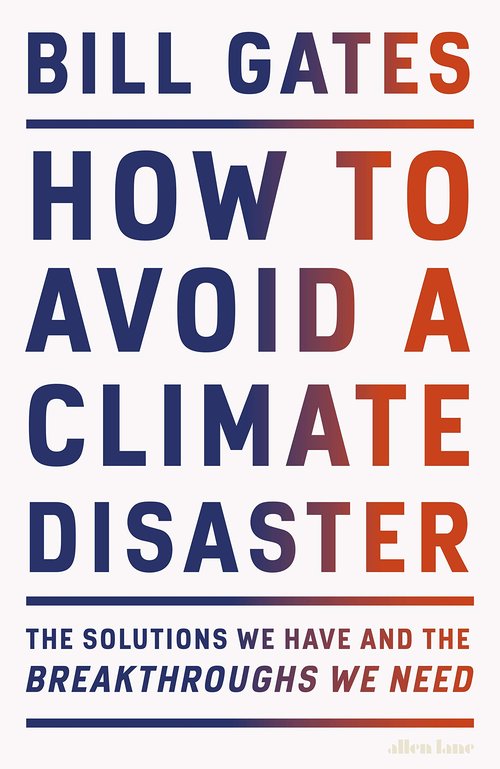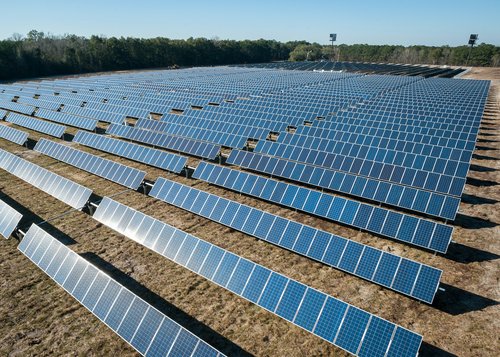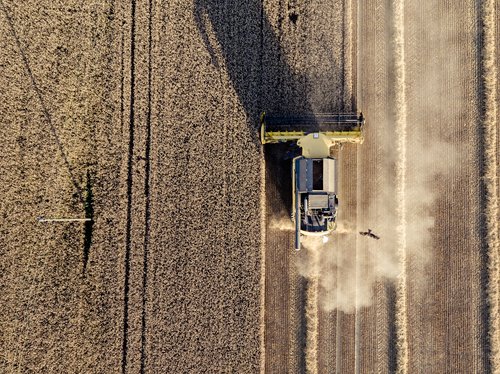How To Pay For Going Green – Bill Gates & The Green Premium
Monday, 01 March 2021By John Adams & Bob Colins
REVIEW: How to avoid Climate Disaster by Bill Gates. (Allen Lane, 2021)

I came to the newly published Bill Gates book on climate change with some concerns but came away disarmed by his commitment and openness. My basic criticism of How to avoid Climate Disaster is best set out by the author himself: “I own big houses and fly in private planes, so who am I to lecture anyone on the environment ?” Also, Gates advocacy of untried technical solutions, with perhaps unforeseeable consequences, such as distributing heat-reflecting fine particles in the upper atmosphere (‘geoengineering’), is suspect. But his heart and also his money seem to be in the right place. This book is a good primer for the main issues.
Gates has a folksy style, rendered somewhat quaint by the US use of Fahrenheit, the long-abandoned Queen Anne 1707 US ‘gallons’ and of non-metric short tons. Indeed, most of the book is aimed at the US public. But at least Gates the billionaire is engaged and committed here on earth - and unlike his fellow billionaire and neighbour, Mr Musk, he is not involved in pointless energy-hungry Bitcoin mining or putting people in his electric vehicles on the dead planet of Mars.
Indeed, Gates makes no bones about being committed to finding a tech solution to providing clean affordable electricity (and education and healthcare) to the world’s poorest. This is an admirable aspiration but will require a 50% increase in the world’s electricity generation to reach even the current per capita level of consumption in China. To reach the per capita level of the US would require a fourfold increase in world generation capacity.
This is before climate change kicks in, and possessing aircon becomes a life-or-death matter rather than a luxury. According to Gates, by 2050 aircon worldwide will consume as much electricity as India and China together. Let us pray it is not generated from coal-fired sources.
Gates affirms categorically that decarbonisation by 2030 is not now feasible. We may however still make bad but easy choices, such as going for gas-fired electric power stations, with lower emission levels than coal, but longer running lives. He aims to go after zero-carbon now. His corollary is simple: only nuclear reactors can supply the clean energy we need. This latter option is both favoured and funded by Gates’ Terrapower. But after Three Mile Island (1979), Chernobyl (1986) and Fukushima (2011) a nuclear power strategy, he recognises, will be difficult to sell.

Gates’ nuclear research suggests that AI can reduce human operating error and improve safety. Nuclear waste can also be reduced, and the plants buried underground against attack. But this is all in computer simulations since no Gates plants have yet been built, though a prototype is in development. In its favour, Gates shows that the carbon footprint of constructing nuclear power stations (cement, steel, glass etc) is less than a coal-fired station, and lower by a factor of five or six than hydro or solar power. Decommissioning costs are of course still high and unpredictable. Apart from his being able to bear the cost, it somehow requires real vision and audacity on Gates’ part to own a nuclear reactor.
Gates had one telling financial blindspot, an omission, and rather an odd one for a billionaire. There is almost no discussion in his book of the power of investors to change the type of projects we choose to fund with our money. Gates is dismissive of this approach which he categories as ‘the easy stuff – divesting securities….’ and sustainable and green finance do not seem to feature in his landscape, though curiously he does state that he divested his own holdings in gas and oil companies in 2019.
However, divestment is, in fact, a major international theme at the moment with fund managers, ranging from Larry Fink’s colossal BlackRock to the much smaller Scottish Widows pension fund, which has just issued a three-year divestment policy for greenhouse gas polluters. Rather disappointingly, Gates’ list of ‘to do things’ for individuals at the end of his book, does not includechecking with the manager of your pension fund to see if it meets green and sustainable criteria. This is probably the most powerful thing you as an individual can do, at least in financial terms.
Nonetheless part of Gates’ financial solution is to mobilise capital for research to cut what he calls the 'Green Premium' – the extra fuel costs that going green will bring. For the average US electricity consumer, he calculates a green solution would be a modest US$216 increase in payment per year (say £165). One suspects however, that the problem for the US may not be financial but political, given that a fair number of Americans are in denial over climate change in general, and in particular believe that frozen wind turbines caused the Texas power outages. (They had, in fact, switched off automatically as they sensed a grid failure).

In this regard, Gates, interestingly, is running a project (Breakthrough Energy) to link up local US electricity networks in regional grids -lack of which seems to have been the major cause of the outages in Texas and other nearby states. The problem again seems to be political rather than technical – one of Texas opting out of federal regulations. This lack of coordination in the US may come as a surprise to integrated networks such as the EU and China. China has even set up an organisation (GEIDCO) to examine the possibility of a world electricity grid, through global grid integration.
Given these divergences, the US may have real trouble in asserting its leadership credentials on climate issues, despite President Biden immediately re-joining the UN Paris Agreement on national climate change targets last month. The UN COP26 meeting in Glasgow in November 2021 could a major test for the US – if it is not postponed again.
The problem of paying the cost of the 'Green Premium' becomes even more acute when it applied to fuel for cargo ships – currently paying US$1.29 per US gallon, but rising to perhaps a high of US$9.05 for green fuel. An expensive way to bring container ships full of consumer goodies from China. The situation is similar for aviation fuel: a gallon of conventional jet fuel is US$2.22, while bio-jet fuel is US$5.35. There is another problem with the Green Premium: as the price of fuel falls, the Green Premium cost increases. This raises the interesting question of what will happen if oil prices fall heavily over the next decade, as vehicles switch to electricity and oil becomes a ‘stranded asset’ (another key financial term absent from this book).
In this regard there will be international banning of petrol (‘gas’) and diesel cars after a certain date – 2030 in the UK, with a similar date proposed for all of the EU. In the US, only California proposes to do this, from 2035….again a state rather than a federal decision, and in stark contrast to China which will ban all its oil-fuelled vehicles from 2035.
Gates realises that cutting the Green Premium will prove almost impossible to fund commercially. His answer is for an application of scale – commissioning larger fleets of electric vehicles (Shenzhen in China, he notes, has a fleet of 16,000 buses), persuading governments to fund research, and pricing carbon realistically through trading emission allowances.
But we are not even out of the Covid-19 woods yet, and the promised spring-back of the world economy has yet to be sustained. Many countries seem to be being driven by economic considerations to pursue a ‘business as usual’ carbon-based growth strategy, and climate change measures may consequently be postponed still further. Only a third of the Paris Agreement signatories had submitted new emission targets for their ‘Nationally Determined Contributions’ at the required end 2020 deadline. The US, China and India (together 50% of the world’s total greenhouse gases) were all notably absent.
Bill Gates is of the opinion that the process of adopting clean power is primarily about getting the technological capabilities and cost reduction in place - he is clearly not naive in this regard. Then and only then will governments be willing to add in a bit of fiscal encouragement, and non-philanthropic investors vote with their funding. The latter can certainly be enablers but are always going to be primarily followers (of the money) rather than leaders. Where technologists like Gates lead, bankers hopefully will follow.
Gates is good on China (where 28% of greenhouse gases originate) but in a depressing fashion. China, he notes, has managed to cut the cost of building new coal-fired power stations by 75%. If it now exports this cheap solution to other Asian states, or along the Silk Road, it will be, as Gates states ‘a disaster for the climate’. Similarly, China is now producing as much cement every three years as the US consumed in the whole of the whole twentieth century. China is also now the world’s largest producer of steel and gold, two other highly polluting industries.

China’s appetite is not restricted to the consumption of industrial commodities. It has, as Gates notes, developed a taste for meat, particularly poultry and pork. These animals consume agricultural feedstock (such as soy and corn) at a ratio of 2-3 times the calories we get from eating their flesh. We are creating a net food deficit, with important implications for world agriculture and nutrition.
It is also patently clear that not everyone, particularly in the US, shares what Mark Carney calls ‘The Tragedy of the Horizon’ – a sense of urgency to act before it is too late. Agreement on addressing air pollution has been easy – smog and smarting eyes are literally in your face, now and undeniable. A climate change event horizon in 2030 is much less so.
In finance, we still have a decade or two before the City of London, Pudong financial centre in Shanghai and New York’s Wall Street are annually flooded by rising sea levels. But as tidal rivers, the Thames, Huangpu and Hudson will eventually all backup, breaching the Bund and the Embankment, flooding the subway systems. We continue to live on expensive climate credit. If we do not act now, sure as fate our children (Bill Gates’ son features in the book) will inherit not our fortunes but our ruinous climate debts.